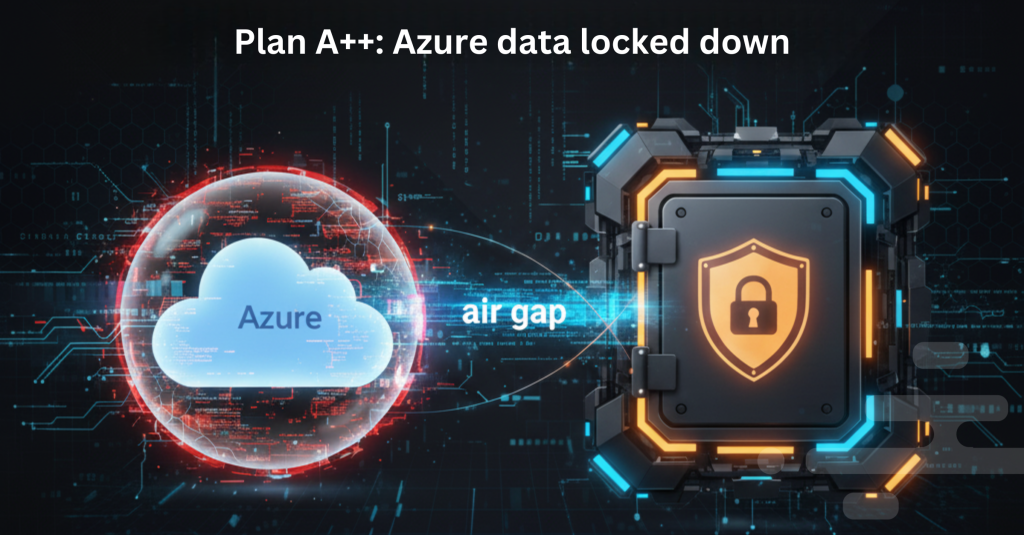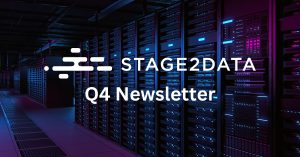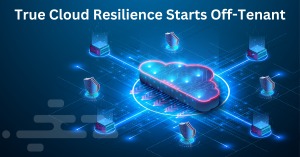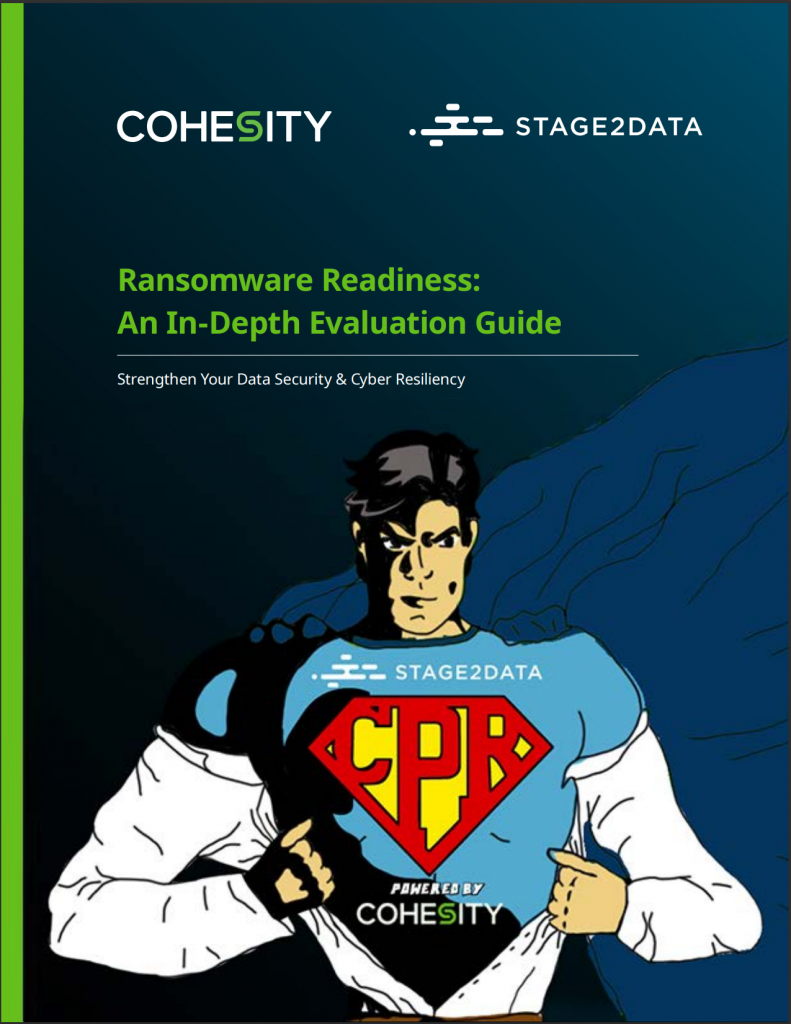You moved your business to Microsoft Azure. That was a smart decision. It gives you power and flexibility you couldn’t easily build yourself. You’re even using Azure’s own tools to back up your data, replicating it between different regions for safety. Another smart move.
You feel prepared. If a data center in one region has a problem, you can fail over to another. If someone accidentally deletes a critical file, you can restore it from a backup. You have a solid “Plan A.”
When Your Azure Backups Are Not Enough
But what happens if someone gets the master keys to your entire Azure account?
We often think about cloud risk in terms of infrastructure failure. A regional power outage, a fiber cut, a cooling system malfunction. These are the known problems, and frankly, ones that cloud providers are very good at handling.
The bigger, quieter threat is the one that bypasses the infrastructure entirely and targets your account directly. A cyberattack can compromise your whole Azure tenant, which is the administrative container holding all your data, users, and applications.
When that happens, an attacker can wipe out your production systems and the backups you were counting on to save you.
Your single backup plan, all neatly contained within Azure, just became a single point of failure. You need a Plan B.
Your "Plan A" Has a Weak Spot
Let’s be clear: Azure’s native backup and site recovery tools are excellent for day-to-day operational issues. They are designed to protect you from common problems like server failures, data corruption, or regional service disruptions. It makes perfect sense to use them. They are convenient, integrated, and feel safe.
Here’s the problem. All those tools and all that data live inside the same security bubble: your Azure tenant. This creates a blind spot in your Azure security model.
Think of the tenant as your company’s digital headquarters in the cloud. It’s controlled by a set of administrator credentials. If an attacker steals those credentials through a sophisticated phishing email or by guessing a weak password, they have the keys to the front door, the server room, and the vault.
This is the danger of tenant compromise, and it’s a scenario that most standard backup plans don’t account for.
Once an attacker has control of a global administrator account, they can move with terrifying speed. They don’t need to break through firewalls or complex network security. They can just log in and:
⚠️ Delete your production virtual machines and databases.
⚠️ Wipe out your storage accounts.
⚠️ And finally, delete every backup and snapshot you have stored within that tenant.
Your geo-redundant recovery plan is gone because the attacker had the power to delete it all. It’s like keeping the only spare key to your house hidden under the doormat. It’s convenient, until someone who shouldn’t have it finds it.
Building a Real Defense: Your Off-Tenant “Plan B”
A real recovery plan needs a fail-safe that exists completely outside the system it’s protecting. You need a backup that is stored in a totally separate place, under a different lock and key. This creates a true “air gap”, a digital separation that an attacker cannot cross. This is your “Plan B”, and it’s called an off-tenant backup.
This is exactly what our Cloud Provider Resiliency (CPR)™ service does. The idea is simple. We use secure, proven technology to copy your virtual machines and data from your public cloud account to our own secure, private cloud.
This isn’t just another copy in a different Azure data center. It’s a replica of your environment that is logically and physically separate from your Azure tenant. It’s in our data center, managed by our team, and secured by our credentials.
It’s your ultimate insurance policy.
If your Azure tenant goes dark because of a cyberattack, your data is safe with us. A hacker with your Azure password has no access to the backups stored in our environment. From there, we have two primary ways to get you back up and running. We can restore your data to a new, clean Azure tenant, or, if the situation requires it, we can actually run your critical systems directly from our cloud until your primary environment is safe to use again.
This gives you a way to continue operating your business, not just recover your data. It turns a potential company-ending event into a manageable problem.
Adding Another Layer: Your Ransomware "Plan C"
An off-tenant backup protects you from an attacker deleting your data. But what about ransomware? This type of attack doesn’t just delete files; it encrypts them, rendering them unusable. Modern ransomware will hunt for your backups and encrypt those, too, rendering them worthless.
This calls for a “Plan C” that provides true ransomware protection: making your backups unchangeable.
We call these immutable snapshots. Once a backup is written, it cannot be changed or deleted for a specific period. Not even by us. Not even by someone with the highest level of admin rights. It’s like a financial ledger; once an entry is made, it can’t be erased. This is a powerful defense. Ransomware works by changing your files. If your backup files cannot be changed, the attack is stopped in its tracks.
We build this protection into our services by working with technology partners like Cohesity, who are leaders in data security. This gives you a guaranteed-clean copy of your data that you can restore from, no matter what a ransomware attack tries to do. We saw this firsthand with a client, CES Energy Solutions. When they were hit by ransomware, we were able to use our systems to restore their operations the very same day, with no data lost.
It's About People, Not Just Products
Technology is only part of the solution. When a disaster happens, you don’t want to be reading a technical manual or waiting in a support queue. You want to talk to a person who knows your environment and can help you immediately.
A true resilience plan includes a team of experts you can call on. We saw this in action in late 2024 with one of our managed service provider (MSP) partners. Their client, a mid-sized financial services company, was struggling with unreliable backups and rising costs from a major cloud provider. By switching to Stage2Data, the MSP was able to provide a solution that delivered a 30% cost savings on cloud disaster recovery and improved the client’s recovery times.
That’s the difference between a vendor and a partner. It’s having a team on standby that delivers real results and takes the pressure off of you, so you can focus on running your business.
Are You Ready for the Real Threats?
Moving to Azure gives your business a huge advantage. But it also introduces new risks that go beyond simple outages. Relying only on the tools inside your Azure tenant is a gamble.
Ask your team a direct question: “What is our plan if we cannot log into our Azure account tomorrow?”
If the answer is unclear, or if it relies entirely on backups stored within that same account, it’s time to rethink your Azure backup strategy. Your recovery plan must survive not just a system failure, but a direct attack on your cloud account. Having a Plan B isn’t just a good idea; it’s the only way to be sure you can get back to business when things go wrong.
Join the Stage2Data Partner Program
The DRaaS market is growing fast, and MSPs have an incredible opportunity to lead the way. Partnering with Stage2Data means offering your clients more than just disaster recovery. It means giving them better value, service, and peace of mind—all while growing your own business.
Getting started is easy. Our team will guide you through the process, from initial setup to training and beyond. You’ll have access to the tools and support you need to succeed, all without the red tape that comes with larger providers.





